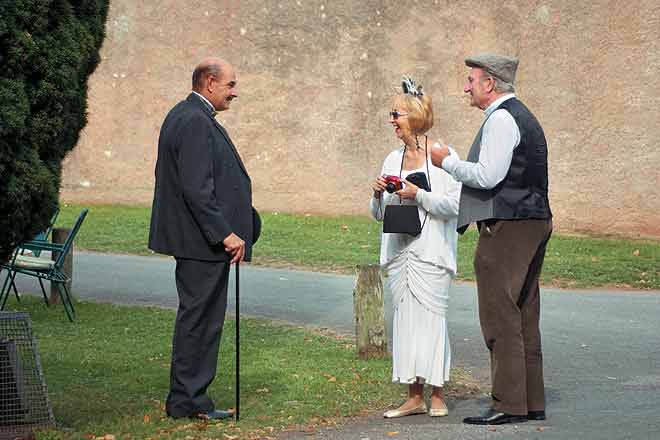Torquay, Devon, just celebrated the week-long Agatha Christie International festival.
We were lucky enough to be at Torquay on the opening day of the festival — September 14, a day before her birthday. Even when the festival isn’t in town, on any ordinary day too, Torquay, on the English Riviera, is as much about Agatha Christie as it is about sea, sand, palm trees and clotted Devon cream. The Queen of Crime was born here, and even today she reigns supreme in the town — on the signboards hanging from lampposts, in shop windows, the museum, the themed bus and boat rides. I, a diehard Christie fan, dragged a Christie-ignorant husband and a know-it-all eight-year-old daughter along the Agatha Christie mile, forcing them to admire hallowed places such as the Grand Hotel, where Agatha honeymooned, the Pavilion where she met Archie Christie over a dance, and the cove where she almost drowned. And in the square, where her bust stands, we dug into those sinful Belgium chocolates being sold in gorgeous boxes with pictures of Poirot printed on them.
But the best was in store for us at Torr Abbey, the hub of the festival. Entering this medieval building was like stepping at least 70 to 80 years back in time, with vintage Austins and Buicks lined up at the grounds, women flitting about in knife-pleated skirts, bobbed hairs and cloche hats, and, yes, an immaculately attired Hercule Poirot, waxed moustache, bow-tie, walking stick and all, beaming at us ever-so-politely. (The man, we later learned, is to be the new Hercule Poirot after the famous David Suchet retires.) Rather sheepishly, I, of the windswept hair and rumpled jeans, walked up to Poirot and requested a selfie, half-expecting him to start lecturing me on the importance of order, method and symmetry. Fortunately, he did nothing of the sort, and obliged me with the most Poirotesque grace ever.
A fête was being held upstairs, inside the abbey, and there were stalls selling quaint period knick-knacks such as hatpins, dresses made of velvets and satins, crochet tablecloth, a jigsaw puzzle from the 1920s, a Peter Rabbit first edition, and a battered tin trunk. In the hallway below, a crime-thriller author sat smiling at a table signing her newly published book. We gathered that this year’s main festival attraction would be Sophie Hannah, with her newly launched Poirot continuation novel — The Monogram Murders.
Our daughter was given a worksheet and a pencil — she had to follow the trail of the teasel mice placed around the Abbey and work out the final clue to possibly a prize. While daughter frantically looked for the mice, mother had a ball of a time guessing the names of the Agatha Christie novels from the clues placed in the Potent Plants’ Garden — a garden of poisonous plants built in memory of Agatha Christie (remember all the taxine, morphine, belladona and datura poisoning in her stories?).
What a shame that we had to leave Torquay that afternoon. With Black Coffee to be staged by the Agatha Christie Theatre Company that very evening, and the high tea with Tommy and Tuppence coming up the next day, leaving Torquay prematurely seemed an unpardonable crime that neither Hercule Poirot nor Miss Marple would have approved of.
England
Torquay
Leave a Reply
You must be logged in to post a comment.


